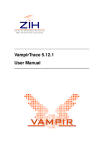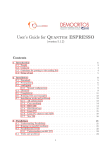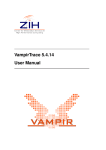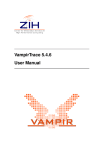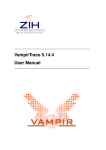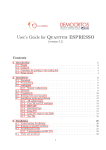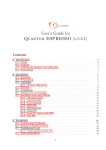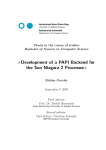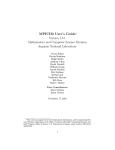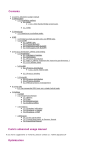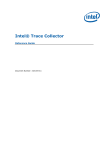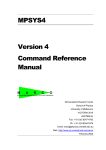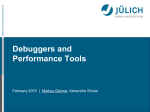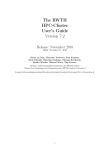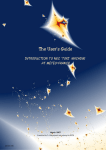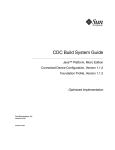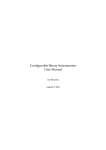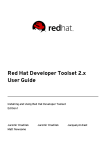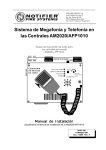Download VampirTrace 5.8.3 User Manual
Transcript
VampirTrace 5.8.3 User Manual TU Dresden Center for Information Services and High Performance Computing (ZIH) 01062 Dresden Germany http://www.tu-dresden.de/zih http://www.tu-dresden.de/zih/vampirtrace Contact: [email protected] ii Contents Contents 1 Introduction 1 2 Instrumentation 2.1 Compiler Wrappers . . . . . . . . . . . . . . . . . . . . . . . . 2.2 Instrumentation Types . . . . . . . . . . . . . . . . . . . . . . 2.3 Automatic Instrumentation . . . . . . . . . . . . . . . . . . . . 2.3.1 Supported Compilers . . . . . . . . . . . . . . . . . . 2.3.2 Notes for Using the GNU, Intel, or PathScale Compiler 2.3.3 Notes on Instrumentation of Inline Functions . . . . . 2.3.4 Instrumentation of Loops with OpenUH Compiler . . . 2.4 Manual Instrumentation . . . . . . . . . . . . . . . . . . . . . 2.4.1 Using the VampirTrace API . . . . . . . . . . . . . . . 2.4.2 Measurement Controls . . . . . . . . . . . . . . . . . . 2.5 Binary Instrumentation Using Dyninst . . . . . . . . . . . . . 2.6 Tracing Java Applications Using JVMTI . . . . . . . . . . . . . 2.7 Tracing Calls to 3rd-Party Libraries . . . . . . . . . . . . . . . . . . . . . . . . . . . . . . . . . . . . . . . . . . . . . . . . . . . . . . 5 5 7 7 8 8 8 9 9 9 10 11 12 12 3 Runtime Measurement 3.1 Trace File Name and Location . . 3.2 Environment Variables . . . . . . 3.3 Influencing Trace Buffer Size . . 3.4 Profiling an Application . . . . . . 3.5 Unification of Local Traces . . . . 3.6 Synchronized Buffer Flush . . . . 3.7 Enhanced Timer Synchronization . . . . . . . . . . . . . . . . . . . . . 15 15 15 18 19 19 20 20 . . . . . . . . . 23 23 24 24 25 25 26 26 27 28 . . . . . . . . . . . . . . . . . . . . . . . . . . . . . . . . . . . 4 Recording Additional Events and Counters 4.1 Hardware Performance Counters . . . . . 4.2 Resource Usage Counters . . . . . . . . 4.3 Memory Allocation Counter . . . . . . . . 4.4 CPU ID Counter . . . . . . . . . . . . . . 4.5 Pthread API Calls . . . . . . . . . . . . . 4.6 I/O Calls . . . . . . . . . . . . . . . . . . . 4.7 fork/system/exec Calls . . . . . . . . . . . 4.8 MPI Correctness Checking Using UniMCI 4.9 User-defined Counters . . . . . . . . . . . . . . . . . . . . . . . . . . . . . . . . . . . . . . . . . . . . . . . . . . . . . . . . . . . . . . . . . . . . . . . . . . . . . . . . . . . . . . . . . . . . . . . . . . . . . . . . . . . . . . . . . . . . . . . . . . . . . . . . . . . . . . . . . . . . . . . . . . . . . . . . . . . . . . . . . . . . . . . . . . . . . . . . . . . . . . . . . . . . . . . . . . . . . . . . . . . . . iii Contents 4.10 User-defined Markers . . . . . . . . . . . . . . . . . . . . . . . . . 30 5 Filtering & Grouping 31 5.1 Function Filtering . . . . . . . . . . . . . . . . . . . . . . . . . . . . 31 5.2 Java Specific Filtering . . . . . . . . . . . . . . . . . . . . . . . . . 32 5.3 Function Grouping . . . . . . . . . . . . . . . . . . . . . . . . . . . 32 A VampirTrace Installation A.1 Basics . . . . . . . . A.2 Configure Options . A.3 Cross Compilation . A.4 Environment Set-Up A.5 Notes for Developers . . . . . . . . . . . . . . . . . . . . . . . . . . . . . . . . . . . . . . . . . . . . . . . . . . . . . . . . . . . . . . . . . B Command Reference B.1 Compiler Wrappers (vtcc,vtcxx,vtf77,vtf90) . B.2 Local Trace Unifier (vtunify) . . . . . . . . . B.3 Dyninst Mutator (vtdyn) . . . . . . . . . . . B.4 Trace Filter Tool (vtfilter) . . . . . . . . . . . B.5 Library Wrapper Generator (vtlibwrapgen) . C Counter Specifications C.1 PAPI . . . . . . . . . . . . . . . . . . . . . C.2 CPC . . . . . . . . . . . . . . . . . . . . . C.3 NEC SX Hardware Performance Counter C.4 Resource Usage . . . . . . . . . . . . . . D FAQ D.1 D.2 D.3 D.4 D.5 D.6 D.7 D.8 . . . . . . . . . . . . . . . . . . . . . . . . . . . . . . . . . . . . . . . . . . . . . . . . . . . . . . . . . . . . . . . . . . . . . . . . . . . . . . . . . . . . . . . . . . . . . . . . . . . . . . . . . . . . . . . . . . . . . . . . . . . . . . . . . . . . . . . . . . . . . . . . . . . . . . . . . . . . . . . . . . . . . . . . . . . . . . . . . 35 35 35 41 42 42 . . . . . 43 43 44 46 47 49 . . . . 53 53 55 56 57 59 59 59 59 60 60 60 61 Can I use different compilers for VampirTrace and my application? Why does my application takes such a long time to start up? . . . How can I trace functions in shared libraries? . . . . . . . . . . . . How can I speed up trace unification? . . . . . . . . . . . . . . . . There is no *.otf file. What can I do? . . . . . . . . . . . . . . . . . What limitations are associated with VT ON/VT OFF? . . . . . . . VampirTrace warns that it “cannot lock file a.lock”, what’s wrong? . Can I re-locate my VampirTrace installation without re-build from source? . . . . . . . . . . . . . . . . . . . . . . . . . . . . . . . . . 61 D.9 I have a question that is not answered in this document! . . . . . . 61 D.10 I need support for additional features so I can trace application xyz. 61 This documentation describes how to apply VampirTrace to an application in order to generate trace files at execution time. This step is called instrumentation. It furthermore explains how to control the runtime measurement system during execution (tracing). This also includes performance counter sampling as well as selective filtering and grouping of functions. iv 1 Introduction 1 Introduction VampirTrace consists of a tool set and a runtime library for instrumentation and tracing of software applications. It is particularly tailored to parallel and distributed High Performance Computing (HPC) applications. The instrumentation part modifies a given application in order to inject additional measurement calls during runtime. The tracing part provides the actual measurement functionality used by the instrumentation calls. By this means, a variety of detailed performance properties can be collected and recorded during runtime. This includes function enter and leave events, MPI communication, OpenMP events, and performance counters. After a successful tracing run, VampirTrace writes all collected data to a trace file in the Open Trace Format (OTF)1 . As a result, the information is available for post-mortem analysis and visualization by various tools. Most notably, VampirTrace provides the input data for the Vampir analysis and visualization tool 2 . VampirTrace is included in Open MPI 1.3 and later versions. If not disabled explicitly, VampirTrace is built automatically when installing Open MPI 3 . Trace files can quickly become very large, especially with automatic instrumentation. Tracing applications for only a few seconds can result in trace files of several hundred megabytes. To protect users from creating trace files of several gigabytes, the default behavior of VampirTrace limits the internal buffer to 32 MB per process. Thus, even for larger scale runs the total trace file size will be moderate. Please read Section 3.3 on how to remove or change this limit. VampirTrace supports various Unix and Linux platforms that are common in HPC nowadays. It is available as open source software under a BSD License. The following list shows a summary of all instrumentation and tracing features that VampirTrace offers. Note that not all features are supported on all platforms. Tracing of user functions ⇒ Chapter 2 • • • • Record function enter and leave events Record name and source code location (file name, line) Automatic instrumentation with many compilers and via Dyninst Manual instrumentation using VampirTrace API 1 http://www.tu-dresden.de/zih/otf http://www.vampir.eu 3 http://www.open-mpi.org/faq/?category=vampirtrace 2 1 MPI Tracing ⇒ Chapter 2 • Record MPI functions • Record MPI communication: participating processes, transferred bytes, tag, communicator OpenMP Tracing ⇒ Chapter 2 • OpenMP directives, synchronization, thread idle time • Also hybrid (MPI and OpenMP) applications are supported Pthread Tracing • Trace POSIX thread API calls ⇒ Section 4.5 • Also hybrid (MPI and POSIX threads) applications are supported Java Tracing ⇒ Chapter 2 • Record method calls • Using JVMTI as interface between VampirTrace and Java Applications 3rd-Party Library tracing ⇒ Section 2.7 • Trace calls to arbitrary third party libraries • Generate wrapper for library functions based on library’s header file(s) • No recompilation of application or library is required MPI Correctness Checking ⇒ Section 4.8 • Record MPI usage errors • Using UniMCI as interface between VampirTrace and a MPI correctness checking tool (e.g. Marmot) User API • • • • Manual instrumentation of source code regions ⇒ Section 2.4.1 Measurement controls ⇒ Section 2.4.2 User-defined counters ⇒ Section 4.9 User-defined marker ⇒ Section 4.10 Performance Counters ⇒ Sections 4.1 and 4.2 • Hardware performance counters using PAPI, CPC, or NEC SX performance counter • Resource usage counters using getrusage Memory Tracing ⇒ Section 4.3 • Trace GLIBC memory allocation and free functions • Record size of currently allocated memory as counter 2 1 Introduction I/O Tracing ⇒ Section 4.6 • Trace LIBC I/O calls • Record I/O events: file name, transferred bytes CPU ID Tracing ⇒ Section 4.4 • Trace core ID of a CPU on which the calling thread is running • Record core ID as counter Fork/System/Exec Tracing ⇒ Section 4.7 • Trace applications calling LIBC’s fork, system, or one of the exec functions • Add forked processes to the trace Filtering & Grouping ⇒ Chapter 5 • Runtime and post-mortem filter (i.e. exclude functions from being recorded in the trace) • Runtime grouping (i.e. assign functions to groups for improved analysis) OTF Output ⇒ Chapter 3 • Writes compressed OTF files • Output as trace file, statistical summary (profile), or both 3 4 2 Instrumentation 2 Instrumentation To perform measurements with VampirTrace, the user’s application program needs to be instrumented, i.e., at specific points of interest (called “events”) VampirTrace measurement calls have to be activated. As an example, common events are, amongst others, entering and leaving of functions as well as sending and receiving of MPI messages. VampirTrace handles this automatically by default. In order to enable the instrumentation of function calls, the user only needs to replace the compiler and linker commands with VampirTrace’s wrappers, see Section 2.1 below. VampirTrace supports different ways of instrumentation as described in Section 2.2. 2.1 Compiler Wrappers All the necessary instrumentation of user functions, MPI, and OpenMP events is handled by VampirTrace’s compiler wrappers (vtcc, vtcxx, vtf77, and vtf90). In the script used to build the application (e.g. a makefile), all compile and link commands should be replaced by the VampirTrace compiler wrapper. The wrappers perform the necessary instrumentation of the program and link the suitable VampirTrace library. Note that the VampirTrace version included in Open MPI 1.3 has additional wrappers (mpicc-vt, mpicxx-vt, mpif77vt, and mpif90-vt) which are like the ordinary MPI compiler wrappers (mpicc, mpicxx, mpif77, and mpif90) with the extension of automatic instrumentation. The following list shows some examples specific to the parallelization type of the program: • Serial programs: Compiling serial codes is the default behavior of the wrappers. Simply replace the compiler by VampirTrace’s wrapper: original: gfortran hello.f90 -o hello with instrumentation: vtf90 hello.f90 -o hello This will instrument user functions (if supported by the compiler) and link the VampirTrace library. • MPI parallel programs: MPI instrumentation is always handled by means of the PMPI interface, which is part of the MPI standard. This requires the compiler wrapper to link with an MPI-aware version of the VampirTrace library. If your MPI implementation uses special MPI compilers (e.g. mpicc, 5 2.1 Compiler Wrappers mpxlf90), you will need to tell VampirTrace’s wrapper to use this compiler instead of the serial one: original: mpicc hello.c -o hello with instrumentation: vtcc -vt:cc mpicc hello.c -o hello MPI implementations without own compilers require the user to link the MPI library manually. In this case, simply replace the compiler by VampirTrace’s compiler wrapper: original: icc hello.c -o hello -lmpi with instrumentation: vtcc hello.c -o hello -lmpi If you want to instrument MPI events only (this creates smaller trace files and less overhead) use the option -vt:inst manual to disable automatic instrumentation of user functions (see also Section 2.4.1). • Threaded parallel programs: When VampirTrace detects OpenMP or Pthread flags on the command line, special instrumentation calls are invoked. For OpenMP events OPARI is invoked for automatic source code instrumentation. original: ifort <-openmp|-pthread> hello.f90 -o hello with instrumentation: vtf90 <-openmp|-pthread> hello.f90 -o hello For more information about OPARI read the documentation available in VampirTrace’s installation directory at: share/vampirtrace/doc/ opari/Readme.html • Hybrid MPI/Threaded parallel programs: With a combination of the above mentioned approaches, hybrid applications can be instrumented: original: mpif90 <-openmp|-pthread> hello.F90 -o hello with instrumentation: vtf90 -vt:f90 mpif90 <-openmp|-pthread> hello.F90 -o hello The VampirTrace compiler wrappers automatically try to detect which parallelization method is used by means of the compiler flags (e.g. -lmpi, -openmp or -pthread) and the compiler command (e.g. mpif90). If the compiler wrapper failed to detect this correctly, the instrumentation could be incomplete and an unsuitable VampirTrace library would be linked to the binary. In this case, you should tell the compiler wrapper which parallelization method your program uses 6 2 Instrumentation by using the switches -vt:mpi, -vt:mt, and -vt:hyb for MPI, multithreaded, and hybrid programs, respectively. Note that these switches do not change the underlying compiler or compiler flags. Use the option -vt:verbose to see the command line that the compiler wrapper executes. See Section B.1 for a list of all compiler wrapper options. The default settings of the compiler wrappers can be modified in the files share/vampirtrace/vtcc-wrapper-data.txt (and similar for the other languages) in the installation directory of VampirTrace. The settings include compilers, compiler flags, libraries, and instrumentation types. You could for instance modify the default C compiler from gcc to mpicc by changing the line compiler=gcc to compiler=mpicc. This may be convenient if you instrument MPI parallel programs only. 2.2 Instrumentation Types The wrapper option -vt:inst <insttype> specifies the instrumentation type to be used. The following values for <insttype> are possible: • compinst Fully-automatic instrumentation by the compiler (⇒ Section 2.3) • manual Manual instrumentation by using VampirTrace’s API (⇒ Section 2.4.1) (needs source-code modifications) • dyninst Binary-instrumentation with Dyninst (⇒ Section 2.5) To determine which instrumentation type will be used by default and which instrumentation types are available on your system have a look at the entry inst avail in the wrapper’s configuration file (e.g. share/vampirtrace/ vtcc-wrapper-data.txt in the installation directory of VampirTrace for the C compiler wrapper). See Section B.1 or type vtcc -vt:help for other options that can be passed to VampirTrace’s compiler wrapper. 2.3 Automatic Instrumentation Automatic instrumentation is the most convenient method to instrument your program. If available, simply use the compiler wrappers without any parameters, e.g.: % vtf90 hello.f90 -o hello 7 2.3 Automatic Instrumentation 2.3.1 Supported Compilers VampirTrace supports following compilers for automatic instrumentation: • GNU (i.e. gcc, g++, gfortran, g95) • Intel version ≥10.0 (i.e. icc, icpc, ifort) • PathScale version ≥3.1 (i.e. pathcc, pathCC, pathf90) • Portland Group (PGI) (i.e. pgcc, pgCC, pgf90, pgf77) • SUN Fortran 90 (i.e. cc, CC, f90) • IBM (i.e. xlcc, xlCC, xlf90) • NEC SX (i.e. sxcc, sxc++, sxf90) • OpenUH version ≥4.0 (i.e. uhcc, uhCC, uhf90) 2.3.2 Notes for Using the GNU, Intel, or PathScale Compiler For these compilers the command nm is required to get symbol information of the running application executable. For example on Linux systems, this program is a part of the GNU Binutils, which is downloadable from http://www.gnu. org/software/binutils. To get the application executable for nm during runtime, VampirTrace uses the /proc file system. As /proc is not present on all operating systems, automatic symbol information might not be available. In this case, it is necessary to set the environment variable VT APPPATH to the pathname of the application executable to get symbols resolved via nm. Should any problems emerge to get symbol information automatically, then the environment variable VT GNU NMFILE can be set to a symbol list file, which is created with the command nm, like: % nm hello > hello.nm To get the source code line for the application functions use nm -l on Linux systems. VampirTrace will include this information into the trace. Note that the output format of nm must be written in BSD-style. See the manual page of nm to obtain help for dealing with the output format setting. 2.3.3 Notes on Instrumentation of Inline Functions Compilers behave differently when they automatically instrument inlined functions. The GNU and Intel ≥10.0 compilers instrument all functions by default 8 2 Instrumentation when they are used with VampirTrace. They therefore switch off inlining completely, disregarding the optimization level chosen. One can prevent these particular functions from being instrumented by appending the following attribute to function declarations, hence making them able to be inlined (this works only for C/C++): __attribute__ ((__no_instrument_function__)) The PGI and IBM compilers prefer inlining over instrumentation when compiling with enabled inlining. Thus, one needs to disable inlining to enable the instrumentation of inline functions and vice versa. The bottom line is that a function cannot be inlined and instrumented at the same time. For more information on how to inline functions read your compiler’s manual. 2.3.4 Instrumentation of Loops with OpenUH Compiler The OpenUH compiler provides the possibility of instrumenting loops in addition to functions. To use this functionality add the compiler flag -OPT:instr loop. In this case loops induce additional events including the type of loop (e.g. for, while, or do) and the source code location. 2.4 Manual Instrumentation 2.4.1 Using the VampirTrace API The VT USER START, VT USER END calls can be used to instrument any userdefined sequence of statements. Fortran: #include "vt_user.inc" VT_USER_START(’name’) ... VT_USER_END(’name’) C: #include "vt_user.h" VT_USER_START("name"); ... VT_USER_END("name"); If a block has several exit points (as it is often the case for functions), all exit points have to be instrumented with VT USER END, too. 9 2.4 Manual Instrumentation For C++ it is simpler as is demonstrated in the following example. Only entry points into a scope need to be marked. The exit points are detected automatically when C++ deletes scope-local variables. C++: #include "vt_user.h" { VT_TRACER("name"); ... } The instrumented sources have to be compiled with -DVTRACE for all three languages, otherwise the VT * calls are ignored. Note that Fortran source files instrumented this way have to be preprocessed, too. In addition, you can combine this particular instrumentation type with all other types. In such a way, all user functions can be instrumented by a compiler while special source code regions (e.g. loops) can be instrumented by VT’s API. Use VT’s compiler wrapper (described above) for compiling and linking the instrumented source code, such as: • combined with automatic compiler instrumentation: % vtcc -DVTRACE hello.c -o hello • without compiler instrumentation: % vtcc -vt:inst manual -DVTRACE hello.c -o hello Note that you can also use the option -vt:inst manual with non-instrumented sources. Binaries created in this manner only contain MPI and OpenMP instrumentation, which might be desirable in some cases. 2.4.2 Measurement Controls Switching tracing on/off: In addition to instrumenting arbitrary blocks of code, one can use the VT ON/ VT OFF instrumentation calls to start and stop the recording of events. These constructs can be used to stop recording of events for a part of the application and later resume recording. For example, one could not collect trace events during the initialization phase of an application and turn on tracing for the computation part. Furthermore the ”on/off” functionality can be used to control the tracing behavior of VampirTrace and allows to trace only parts of interests. Therefore the amount of trace data can be reduced essentially. To check whether if tracing is enabled or not use the call VT IS ON. 10 2 Instrumentation Please note that stopping and starting the recording of events has to be performed at the same call stack level. If this is not the case, an error message will be printed during runtime and VampirTrace will abort execution. For further information have a look at the FAQ D.6. Intermediate buffer flush: In addition to an automated buffer flush when the buffer is filled, it is possible to flush the buffer at any point of the application. This way you can guarantee that after a manual buffer flush there will be a sequence of the program with no automatic buffer flush interrupting. To flush the buffer you can use the call VT BUFFER FLUSH. Intermediate time synchronisation: VampirTrace provides several mechanisms for timer synchronization (⇒ Section 3.7). In addition it is also possible to initiate a timer synchronization at any point of the application by calling VT TIMESYNC. Please note that the user has to ensure that all processes are actual at a synchronized point in the program (e.g. at a barrier). To use this call make sure that the enhanced timer synchronization is activated (set the environment variable VT ETIMESYNC ⇒ Section 3.2). Intermediate counter update: VampirTrace provides the functionality to collect the values of arbitrary hardware counters. Chosen counter values are automatically recorded whenever an event occurs. Sometimes (e.g. within a longlasting function) it is desirable to get the counter values at an arbitrary point within the program. To record the counter values at any given point you can call VT UPDATE COUNTER. Note: For all three languages the instrumented sources have to be compiled with -DVTRACE. Otherwise the VT * calls are ignored. In addition, if the sources contains further VampirTrace API calls and only the calls for measurement controls shall be disabled, then the sources have to be compiled with -DVTRACE NO CONTROL, too. 2.5 Binary Instrumentation Using Dyninst The option -vt:inst dyninst is used with the compiler wrapper to instrument the application during runtime (binary instrumentation), by using Dyninst 1 . Recompiling is not necessary for this kind of instrumentation, but relinking: % vtf90 -vt:inst dyninst hello.o -o hello The compiler wrapper dynamically links the library libvt-dynatt.so to the 1 http://www.dyninst.org 11 2.6 Tracing Java Applications Using JVMTI application. This library attaches the Mutator -program vtdyn during runtime which invokes the instrumentation by using the Dyninst-API. Note that the application should have been compiled with the -g switch to have visible symbol names. After a tracing run with this kind of instrumentation, the vtunify utility needs to be invoked manually (⇒ Sections 3.5 and B.2). To prevent certain functions from being instrumented you can set the environment variable VT DYN BLACKLIST to a file containing a newline-separated list of function names. All additional overhead, due to instrumentation of these functions, will be removed. VampirTrace also allows binary instrumentation of functions located in shared libraries. For this to work the shared libraries have to be compiled with -g and a colon-separated list of their names has to be given in the environment variable VT DYN SHLIBS: VT_DYN_SHLIBS=libsupport.so:libmath.so 2.6 Tracing Java Applications Using JVMTI In addition to C, C++, and Fortran, VampirTrace is capable of tracing Java applications. This is accomplished by means of the Java Virtual Machine Tool Interface (JVMTI) which is part of JDK versions 5 and later. If VampirTrace was built with Java tracing support, the library libvt-java.so can be used as follows to trace any Java program: % java -agentlib:vt-java ... Or more easier, by replacing the usal Java application launcher java by the command vtjava: % vtjava ... When tracing Java applications, you probably want to filter out dispensable function calls. Please have a look at Sections 5.1 and 5.2 to learn about different ways for excluding parts of the application from tracing. 2.7 Tracing Calls to 3rd-Party Libraries VampirTrace is also capable to trace calls to third party libraries which come with at least one C header file even without the library’s source code. If VampirTrace was built with support for library tracing the tool vtlibwrapgen can be used to generate a wrapper library to intercept each call to the actual library functions. This wrapper library can be linked to the application or used in combination with the LD PRELOAD mechanism provided by Linux. The generation of a wrapper library is done using the vtlibwrapgen command and consists of two steps. 12 2 Instrumentation The first step generates a C source file, providing the wrapped functions of the library header file: % vtlibwrapgen -g SDL -o SDLwrap.c /usr/include/SDL/*.h This generates the source file SDLwrap.c that contains wrapper-functions for all library functions found in the header-files located in /usr/include/SDL/ and instructs VampirTrace to assign these functions to the new group SDL. The generated wrapper source file can be edited in order to add manual instrumentation or alter attributes of the library wrapper. A detailed description can be found in the generated source file or in the header file vt libwrap.h which can be found in the include directory of VampirTrace. To adapt the library instrumentation it is possible to pass a filter file to the generation process. The rules are like these for normal VampirTrace instrumentation (see Section 5.1), where only 0 (exclude functions) and -1 (generally include functions) are allowed. The second step is to compile the generated source file: % vtlibwrapgen --build --shared -o libSDLwrap SDLwrap.c This builds the shared library libSDLwrap.so which can be linked to the application or preloaded by using the environment variable LD PRELOAD: % LD_PRELOAD=$PWD/libSDLwrap.so <executable> For more information about the tool vtlibwrapgen see Section B.5. 13 2.7 Tracing Calls to 3rd-Party Libraries 14 3 Runtime Measurement 3 Runtime Measurement Running a VampirTrace instrumented application should normally result in an OTF trace file in the current working directory where the application was executed. If a problem occurs, set the environment variable VT VERBOSE to 2 before executing the instrumented application in order to see control messages of the VampirTrace runtime system which might help tracking down the problem. The internal buffer of VampirTrace is limited to 32 MB per process. Use the environment variables VT BUFFER SIZE and VT MAX FLUSHES to increase this limit. Section 3.3 contains further information on how to influence trace file size. 3.1 Trace File Name and Location The default name of the trace file depends on the operating system where the application is run. On Linux, MacOS and Sun Solaris the trace file will be named like the application, e.g. hello.otf for the executable hello. For other systems, the default name is a.otf. Optionally, the trace file name can be defined manually by setting the environment variable VT FILE PREFIX to the desired name. The suffix .otf will be added automatically. To prevent overwriting of trace files by repetitive program runs, one can enable unique trace file naming by setting VT FILE UNIQUE to yes. In this case, VampirTrace adds a unique number to the file names as soon as a second trace file with the same name is created. A *.lock file is used to count up the number of trace files in a directory. Be aware that VampirTrace potentially overwrites an existing trace file if you delete this lock file. The default value of VT FILE UNIQUE is no. You can also set this variable to a number greater than zero, which will be added to the trace file name. This way you can manually control the unique file naming. The default location of the final trace file is the working directory at application start time. If the trace file shall be stored in another place, use VT PFORM GDIR as described in Section 3.2 to change the location of the trace file. 3.2 Environment Variables The following environment variables can be used to control the measurement of a VampirTrace instrumented executable: 15 3.2 Environment Variables Variable Purpose Default Global Settings VT APPPATH VT BUFFER SIZE VT VT VT VT CLEAN COMPRESSION FILE PREFIX FILE UNIQUE VT MAX FLUSHES VT MAX THREADS VT PFORM GDIR VT PFORM LDIR VT UNIFY VT VERBOSE Path to the application executable. ⇒ Section 2.3.2 Size of internal event trace buffer. This is the place where event records are stored, before being written to a file. ⇒ Section 3.3 Remove temporary trace files? Write compressed trace files? Prefix used for trace filenames. Enable unique trace file naming? Set to yes, no, or a numerical ID. ⇒ Section 3.1 Maximum number of buffer flushes. ⇒ Section 3.3 Maximum number of threads (≤ 65536) per process that VampirTrace reserves resources for. Name of global directory to store final trace file in. Name of node-local directory which can be used to store temporary trace files. Unify local trace files afterwards? Level of VampirTrace related information messages: Quiet (0), Critical (1), Information (2) – 32M yes yes ⇒ Sect. 3.1 no 1 65536 ./ /tmp/ yes 1 Optional Features VT CPUIDTRACE VT ETIMESYNC VT ETIMESYNC INTV VT IOLIB PATHNAME VT IOTRACE VT LIBCTRACE 16 Enable tracing of core ID of a CPU? ⇒ Section 4.4 Enable enhanced timer synchronization? ⇒ Section 3.7 Interval between two successive synchronization phases in s. Provides an alternative library to use for LIBC I/O calls. ⇒ Section 4.6 Enable tracing of application I/O calls? ⇒ Section 4.6 Enable tracing of fork/system/exec calls? ⇒ Section 4.7 calls no no 120 – no yes 3 Runtime Measurement Variable VT MEMTRACE VT MODE VT MPICHECK VT MPICHECK ERREXIT VT MPITRACE VT PTHREAD REUSE VT STAT INV VT STAT PROPS VT SYNC FLUSH VT SYNC FLUSH LEVEL Purpose Enable memory allocation counter? ⇒ Section 4.3 Colon-separated list of VampirTrace modes: Tracing (TRACE), Profiling (STAT). ⇒ Section 3.4 Enable MPI correctness checking via UniMCI? Force trace write and application exit if an MPI usage error is detected? Enable tracing of MPI events? Reuse IDs of terminated Pthreads? Length of interval for writing the next profiling record Colon-separated list of event types that shall be recorded in profiling mode: Functions (FUNC), Messages (MSG), Collective Ops. (COLLOP) or all of them (ALL) ⇒ Section 3.4 Enable synchronized buffer flush? ⇒ Section 3.6 Minimum buffer fill level for synchronized buffer flush in percent. Default no TRACE no no yes yes 0 ALL no 80 Counters VT METRICS VT METRICS SEP VT RUSAGE VT RUSAGE INTV Specify counter metrics to be recorded with trace events as a colon/VT METRICS SEP-separated list of names. ⇒ Section 4.1 Separator string between counter specifications in VT METRICS. Colon-separated list of resource usage counters which shall be recorded. ⇒ Section 4.2 Sample interval for recording resource usage counters in ms. – : – 100 Filtering, Grouping VT DYN BLACKLIST Name of blacklist file for Dyninst instrumentation. ⇒ Section 2.5 – 17 3.3 Influencing Trace Buffer Size Variable VT DYN SHLIBS VT FILTER SPEC VT GROUPS SPEC VT JAVA FILTER SPEC VT GROUP CLASSES VT MAX STACK DEPTH Purpose Colon-separated list of shared libraries for Dyninst instrumentation. ⇒ Section 2.5 Name of function/region filter file. ⇒ Section 5.1 Name of function grouping file. ⇒ Section 5.3 Name of Java specific filter file. ⇒ Section 5.2 Create a group for each Java class automatically? Maximum number of stack level to be traced. (0 = unlimited) Default – – – – yes 0 Symbol List VT GNU NM VT GNU NMFILE Command to list symbols from object files. ⇒ Section 2.3 Name of file with symbol list information. ⇒ Section 2.3 nm – The variables VT PFORM GDIR, VT PFORM LDIR, VT FILE PREFIX may contain (sub)strings of the form $XYZ or ${XYZ} where XYZ is the name of another environment variable. Evaluation of the environment variable is done at measurement runtime. When you use these environment variables, make sure that they have the same value for all processes of your application on all nodes of your cluster. Some cluster environments do not automatically transfer your environment when executing parts of your job on remote nodes of the cluster, and you may need to explicitly set and export them in batch job submission scripts. 3.3 Influencing Trace Buffer Size The default values of the environment variables VT BUFFER SIZE and VT MAX FLUSHES limit the internal buffer of VampirTrace to 32 MB per process and the number of times that the buffer is flushed to 1, respectively. Events that are to be recorded after the limit has been reached are no longer written into the trace file. The environment variables apply to every process of a parallel application, meaning that applications with n processes will typically create trace files n times the size of a serial application. 18 3 Runtime Measurement To remove the limit and get a complete trace of an application, set VT MAX FLUSHES to 0. This causes VampirTrace to always write the buffer to disk when it is full. To change the size of the buffer, use the environment variable VT BUFFER SIZE. The optimal value for this variable depends on the application which is to be traced. Setting a small value will increase the memory available to the application, but will trigger frequent buffer flushes by VampirTrace. These buffer flushes can significantly change the behavior of the application. On the other hand, setting a large value, like 2G, will minimize buffer flushes by VampirTrace, but decrease the memory available to the application. If not enough memory is available to hold the VampirTrace buffer and the application data, parts of the application may be swapped to disk, leading to a significant change in the behavior of the application. Note that you can decrease the size of trace files significantly by using the runtime function filtering as explained in Section 5.1. 3.4 Profiling an Application Profiling an application collects aggregated information about certain events during a program run, whereas tracing records information about individual events. Profiling can therefore be used to get a summary of the program activity and to detect events that are called very often. The profiling information can also be used to generate filter rules to reduce the trace file size (⇒ Section 5.1). To profile an application set the variable VT MODE to STAT. Setting VT MODE to STAT:TRACE tells VampirTrace to perform tracing and profiling at the same time. By setting the variable VT STAT PROPS the user can influence whether functions, messages, and/or collective operations shall be profiled. See Section 3.2 for information about these environment variables. 3.5 Unification of Local Traces After a run of an instrumented application the traces of the single processes need to be unified in terms of timestamps and event IDs. In most cases, this happens automatically. If the environment variable VT UNIFY is set to no or under certain circumstances it is necessary to perform unification of local traces manually. To do this, use the following command: % vtunify <nproc> <prefix> If VampirTrace was built with support for OpenMP and/or MPI, it is possible to speedup the unification of local traces significantly. To distribute the unification on multible processes the MPI parallel version vtunify-mpi can be used as follow: 19 3.6 Synchronized Buffer Flush % mpirun -np <nranks> vtunify-mpi <nproc> <prefix> Furthermore, both tools vtunify and vtunify-mpi are capable to open additional OpenMP threads for unification. The number of threads can be specified by the OMP NUM THREADS environment variable. 3.6 Synchronized Buffer Flush When tracing an application, VampirTrace temporarily stores the recorded events in a trace buffer. Typically, if a buffer of a process or thread has reached its maximum fill level, the buffer has to be flushed and other processes or threads maybe have to wait for this process or thread. This will result in an asynchronous runtime behavior. To avoid this problem, VampirTrace provides a buffer flush in a synchronized manner. That means, if one buffer has reached its minimum buffer fill level VT SYNC FLUSH LEVEL (⇒ Section 3.2), all buffers will be flushed. This buffer flush is only available at appropriate points in the program flow. Currently, VampirTrace makes use of all MPI collective functions associated with MPI COMM WORLD. Use the environment variable VT SYNC FLUSH to enable synchronized buffer flush. 3.7 Enhanced Timer Synchronization Especially on cluster environments, where each process has its own local timer, tracing relies on precisely synchronized timers. Therefore, VampirTrace provides several mechanisms for timer synchronization. The default synchronization scheme is a linear synchronization at the very begin and the very end of a trace run with a master-slave communication pattern. However, this way of synchronization can become to imprecise for long trace runs. Therefore, we recommend the usage of the enhanced timer synchronization scheme of VampirTrace. This scheme inserts additional synchronization phases at appropriate points in the program flow. Currently, VampirTrace makes use of all MPI collective functions associated with MPI COMM WORLD. To enable this synchronization scheme, a LAPACK library with C wrapper support has to be provided for VampirTrace and the environment variable VT ETIMESYNC (⇒ Section 3.2) has to be set before the tracing. The length of the interval between two successive synchronization phases can be adjusted with VT ETIMESYNC INTV. The following LAPACK libraries provide a C-LAPACK API that can be used by VampirTrace for the enhanced timer synchronization: 20 3 Runtime Measurement • CLAPACK1 • AMD ACML • IBM ESSL • Intel MKL • SUN Performance Library Note: Systems equipped with a global timer do not need timer synchronization. Note: It is recommended to combine enhanced timer synchronization and synchronized buffer flush. Note: Be aware that the asynchronous behavior of the application will be disturbed since VampirTrace makes use of asynchronous MPI collective functions for timer synchronization and synchronized buffer flush. Only make use of these approaches, if your application does not rely on an asynchronous behavior! Otherwise, keep this fact in mind during the process of performance analysis. 1 www.netlib.org/clapack 21 3.7 Enhanced Timer Synchronization 22 4 Recording Additional Events and Counters 4 Recording Additional Events and Counters 4.1 Hardware Performance Counters If VampirTrace has been built with hardware counter support (⇒ Appendix A), it is capable of recording hardware counter information as part of the event records. To request the measurement of certain counters, the user is required to set the environment variable VT METRICS. The variable should contain a colonseparated list of counter names or a predefined platform-specific group. The user can leave the environment variable unset to indicate that no counters are requested. If any of the requested counters are not recognized or the full list of counters cannot be recorded due to hardware resource limits, program execution will be aborted with an error message. PAPI Hardware Performance Counters If the PAPI library is used to access hardware performance counters, metric names can be any PAPI preset names or PAPI native counter names. For example, set VT_METRICS=PAPI_FP_OPS:PAPI_L2_TCM:!CPU_TEMP1 to record the number of floating point instructions and level 2 cache misses (PAPI preset counters), cpu temperature from the lm sensors component. The leading exclamation mark let CPU TEMP1 be interpreted as absolute value counter. See Section C.1 for a full list of PAPI preset counters. CPC Hardware Performance Counters On Sun Solaris operating systems VampirTrace can make use of the CPC performance counter library to query the processor’s hardware performance counters. The counters which are actually available on your platform can be queried with the tool vtcpcavail. The listed names can then be used within VT METRICS to tell VampirTrace which counters to record. 23 4.2 Resource Usage Counters NEC SX Hardware Performance Counters On NEC SX machines VampirTrace uses special register calls to query the processor’s hardware counters. Use VT METRICS to specify the counters that have to be recorded. See Section C.3 for a full list of NEC SX hardware performance counters. 4.2 Resource Usage Counters The Unix system call getrusage provides information about consumed resources and operating system events of processes such as user/system time, received signals, and context switches. If VampirTrace has been built with resource usage support, it is able to record this information as performance counters to the trace. You can enable tracing of specific resource counters by setting the environment variable VT RUSAGE to a colon-separated list of counter names, as specified in Section C.4. For example, set VT_RUSAGE=ru_stime:ru_majflt to record the system time consumed by each process and the number of page faults. Alternatively, one can set this variable to the value all to enable recording of all 16 resource usage counters. Note that not all counters are supported by all Unix operating systems. Linux 2.6 kernels, for example, support only resource information for six of them. See Section C.4 and the manual page of getrusage for details. The resource usage counters are not recorded at every event. They are only read if 100 ms have passed since the last sampling. The interval can be changed by setting VT RUSAGE INTV to the number of desired milliseconds. Setting VT RUSAGE INTV to zero leads to sampling resource usage counters at every event, which may introduce a large runtime overhead. Note that in most cases the operating system does not update the resource usage information at the same high frequency as the hardware performance counters. Setting VT RUSAGE INTV to a value less than 10 ms does usually not improve the granularity. Be aware that, when using the resource usage counters for multi-threaded programs, the information displayed is valid for the whole process and not for each single thread. 4.3 Memory Allocation Counter The GNU LIBC implementation provides a special hook mechanism that allows intercepting all calls to memory allocation and free functions (e.g. malloc, 24 4 Recording Additional Events and Counters realloc, free). This is independent from compilation or source code access, but relies on the underlying system library. If VampirTrace has been built with memory-tracing support (⇒ Appendix A), VampirTrace is capable of recording memory allocation information as part of the event records. To request the measurement of the application’s allocated memory, the user must set the environment variable VT MEMTRACE to yes. Note: This approach to get memory allocation information requires changing internal function pointers in a non-thread-safe way, so VampirTrace currently does not support memory tracing for thread-able programs, e.g., programs parallelized with OpenMP or Pthreads! 4.4 CPU ID Counter The GNU LIBC implementation provides a function to determine the core id of a CPU on which the calling thread is running. VampirTrace uses this functionality to record the current core identifier as counter. This feature can be activated by setting the environment variable VT CPUIDTRACE to yes. Note: To use this feature you need the GNU LIBC implementation at least in version 2.6. 4.5 Pthread API Calls When tracing applications with Pthreads, only user events and functions are recorded which are automatically or manually instrumented. Pthread API functions will not be traced by default. To enable tracing of all C-Pthread API functions include the header vt user.h and compile the instrumented sources with -DVTRACE PTHREAD. C/C++: #include "vt_user.h" % vtcc -DVTRACE PTHREAD hello.c -o hello Note: Currently, Pthread instrumentation is only available for C/C++. 25 4.6 I/O Calls 4.6 I/O Calls Calls to functions which reside in external libraries can be intercepted by implementing identical functions and linking them before the external library. Such “wrapper functions” can record the parameters and return values of the library functions. If VampirTrace has been built with I/O tracing support, it uses this technique for recording calls to I/O functions of the standard C library, which are executed by the application. The following functions are intercepted by VampirTrace: close dup2 fgetc fopen64 fread fseeko64 funlockfile lockf open64 puts readv writev creat fclose fgets fprintf fscanf fsetpos fwrite lseek pread pwrite rewind creat64 fcntl flockfile fputc fseek fsetpos64 getc lseek64 pread64 pwrite64 unlink dup fdopen fopen fputs fseeko ftrylockfile gets open putc read write The gathered information will be saved as I/O event records in the trace file. This feature has to be activated for each tracing run by setting the environment variable VT IOTRACE to yes. This works for both dynamically and statically linked executables. Note that when linking statically, a warning like the following may be issued: Using ’dlopen’ in statically linked applications requires at runtime the shared libraries from the glibc version used for linking. This is ok as long as the mentioned libraries are available for running the application. If you’d like to experiment with some other I/O library, set the environment variable VT IOLIB PATHNAME to the alternative one. Beware that this library must provide all I/O functions mentioned above otherwise VampirTrace will abort. 4.7 fork/system/exec Calls If VampirTrace has been built with LIBC trace support (⇒ Appendix A), it is capable of tracing programs which call functions from the LIBC exec family (execl, execlp, execle, execv, execvp, execve), system, and fork. VampirTrace records the call of the LIBC function to the trace. This feature works for sequential (i.e. no MPI or threaded parallelization) programs only. It works for both dynamically and statically linked executables. Note that when linking statically, a 26 4 Recording Additional Events and Counters warning like the following may be issued: Using ’dlopen’ in statically linked applications requires at runtime the shared libraries from the glibc version used for linking. This is ok as long as the mentioned libraries are available for running the application. When VampirTrace detects a call of an exec function, the current trace file is closed before executing the new program. If the executed program is also instrumented with VampirTrace, it will create a different trace file. Note that VampirTrace aborts if the exec function returns unsuccessfully. Calling fork in an instrumented program creates an additional process in the same trace file. 4.8 MPI Correctness Checking Using UniMCI VampirTrace supports the recording of MPI correctness events, e.g., usage of invalid MPI requests. This is implemented by using the Universal MPI Correctness Interface (UniMCI), which provides an interface between tools like VampirTrace and existing runtime MPI correctness checking tools. Correctness events are stored as markers in the trace file and are visualized by Vampir. If VampirTrace is built with UniMCI support, the user only has to enable MPI correctness checking. This is done by merely setting the environment variable VT MPICHECK to yes. Further, if your application crashes due to an MPI error you should set VT MPICHECK ERREXIT to yes. This environmental variable forces VampirTrace to write its trace to disk and exit afterwards. As a result, the trace with the detected error is stored before the application might crash. To install VampirTrace with correctness checking support it is necessary to have UniMCI installed on your system. UniMCI in turn requires you to have a supported MPI correctness checking tool installed, currently only the tool Marmot is known to have UniMCI support. So all in all you should use the following order to install with correctness checking support: 1. Marmot (see http://www.hlrs.de/organization/av/amt/research/marmot) 2. UniMCI (see http://www.tu-dresden.de/zih/unimci) 3. VampirTrace (see http://www.tu-dresden.de/zih/vampirtrace) Information on how to install Marmot and UniMCI is given in their respective manuals. VampirTrace will automatically detect an UniMCI installation if the unimci-config tool is in path. 27 4.9 User-defined Counters 4.9 User-defined Counters In addition to the manual instrumentation (⇒ Section 2.4.1), the VampirTrace API provides instrumentation calls which allow recording of program variable values (e.g. iteration counts, calculation results, ...) or any other numerical quantity. A user-defined counter is identified by its name, the counter group it belongs to, the type of its value (integer or floating-point) and the unit that the value is quoted (e.g. “GFlop/sec”). The VT COUNT GROUP DEF and VT COUNT DEF instrumentation calls can be used to define counter groups and counters: Fortran: #include "vt_user.inc" integer :: id, gid VT_COUNT_GROUP_DEF(’name’, gid) VT_COUNT_DEF(’name’, ’unit’, type, gid, id) C/C++: #include "vt_user.h" unsigned int id, gid; gid = VT_COUNT_GROUP_DEF("name"); id = VT_COUNT_DEF("name", "unit", type, gid); The definition of a counter group is optional. If no special counter group is desired, the default group “User” can be used. In this case, set the parameter gid of VT COUNT DEF() to VT COUNT DEFGROUP. The third parameter type of VT COUNT DEF specifies the data type of the counter value. To record a value for any of the defined counters the corresponding instrumentation call VT COUNT * VAL must be invoked. Fortran: Type VT COUNT VT COUNT VT COUNT VT COUNT C/C++: Type VT COUNT VT COUNT VT COUNT VT COUNT 28 TYPE TYPE TYPE TYPE TYPE TYPE TYPE TYPE INTEGER INTEGER8 REAL DOUBLE Count call VT COUNT INTEGER VAL VT COUNT INTEGER8 VAL VT COUNT REAL VAL VT COUNT DOUBLE VAL Data type integer (4 byte) integer (8 byte) real double precision SIGNED UNSIGNED FLOAT DOUBLE Count call VT COUNT SIGNED VAL VT COUNT UNSIGNED VAL VT COUNT FLOAT VAL VT COUNT DOUBLE VAL Data type signed int (max. 64-bit) unsigned int (max. 64-bit) float double 4 Recording Additional Events and Counters The following example records the loop index i: Fortran: #include "vt_user.inc" program main integer :: i, cid, cgid VT_COUNT_GROUP_DEF(’loopindex’, cgid) VT_COUNT_DEF(’i’, ’#’, VT_COUNT_TYPE_INTEGER, cgid, cid) do i=1,100 VT_COUNT_INTEGER_VAL(cid, i) end do end program main C/C++: #include "vt_user.h" int main() { unsigned int i, cid, cgid; cgid = VT_COUNT_GROUP_DEF(’loopindex’); cid = VT_COUNT_DEF("i", "#", VT_COUNT_TYPE_UNSIGNED, cgid); for( i = 1; i <= 100; i++ ) { VT_COUNT_UNSIGNED_VAL(cid, i); } return 0; } For all three languages the instrumented sources have to be compiled with -DVTRACE. Otherwise the VT * calls are ignored. Optionally, if the sources contain further VampirTrace API calls and only the calls for user-defined counters shall be disabled, then the sources have to be compiled with -DVTRACE NO COUNT in addition to -DVTRACE . 29 4.10 User-defined Markers 4.10 User-defined Markers In addition to the manual instrumentation (⇒ Section 2.4.1), the VampirTrace API provides instrumentation calls which allow recording of special user information, which can be used to better identify parts of interest. A user-defined marker is identified by its name and type. Fortran: #include "vt_user.inc" integer :: mid VT_MARKER_DEF(’name’, type, mid) VT_MARKER(mid, ’text’) C/C++: #include "vt_user.h" unsigned int mid; mid = VT_MARKER_DEF("name",type); VT_MARKER(mid, "text"); Types for Fortran/C/C++: VT_MARKER_TYPE_ERROR VT_MARKER_TYPE_WARNING VT_MARKER_TYPE_HINT For all three languages the instrumented sources have to be compiled with -DVTRACE. Otherwise the VT * calls are ignored. Optionally, if the sources contain further VampirTrace API calls and only the calls for user-defined markers shall be disabled, then the sources have to be compiled with -DVTRACE NO MARKER in addition to -DVTRACE . 30 5 Filtering & Grouping 5 Filtering & Grouping 5.1 Function Filtering By default, all calls of instrumented functions will be traced, so that the resulting trace files can easily become very large. In order to decrease the size of a trace, VampirTrace allows the specification of filter directives before running an instrumented application. The user can decide on how often an instrumented function/region shall be recorded to a trace file. To use a filter, the environment variable VT FILTER SPEC needs to be defined. It should contain the path and name of a file with filter directives. Here is an example of a file containing filter directives: # VampirTrace region filter specification # # call limit definitions and region assignments # # syntax: <regions> -- <limit> # # regions semicolon-separated list of regions # (can be wildcards) # limit assigned call limit # 0 = region(s) denied # -1 = unlimited # add;sub;mul;div -- 1000 * -- 3000000 These region filter directives cause that the functions add, sub, mul and div be recorded at most 1000 times. The remaining functions * will be recorded at most 3000000 times. Besides creating filter files manually, you can also use the vtfilter tool to generate them automatically. This tool reads a provided trace and decides whether a function should be filtered or not, based on the evaluation of certain parameters. For more information see Section B.4. 31 5.2 Java Specific Filtering Rank Specific Filtering An experimental extension allows rank specific filtering. Use @ clauses to restrict all following filters to the given ranks. The rank selection must be given as a list of <from> - <to> pairs or single values. @ 4 - 10, 20 - 29, 34 foo;bar -- 2000 * -- 0 The example defines two limits for the ranks 4 - 10, 20 - 29, and 34. Attention: The rank specific rules are activated later than usual at MPI Init, because the ranks are not available earlier. The special MPI routines MPI Init, MPI Init thread, and MPI Initialized cannot be filtered in this way. 5.2 Java Specific Filtering For Java tracing there are additional possibilities of filtering. Firstly, there is a default filter applied. The rules can be found in the filter file <vt-install>/etc/ vt-java-default-filter.spec . Secondly, user-defined filters can be applied additionally by setting VT JAVA FILTER SPEC to a file containing the rules. The syntax of the filter rules is as follows: <method|thread> <include|exclude> <filter string[;fs]...> Filtering can be done on thread names and method names, defined by the first parameter. The second parameter determines whether the matching item shall be included for tracing or excluded from it. Multiple filter strings on a line have to be separated by ; and may contain occurences of * for wildcard matching. The user-supplied filter rules will be applied before the default filter and the first match counts so it is possible to include items that would be excluded by the default filter otherwise. 5.3 Function Grouping VampirTrace allows assigning functions/regions to a group. Groups can, for instance, be highlighted by different colors in Vampir displays. The following standard groups are created by VampirTrace: 32 5 Filtering & Grouping Group name MPI OMP OMP SYNC OMP PREG Pthreads MEM I/O LIBC Application Contained functions/regions MPI functions OpenMP API function calls OpenMP barriers OpenMP parallel regions Pthread API function calls Memory allocation functions (⇒ Section 4.3) I/O functions (⇒ Section 4.6) LIBC fork/system/exec functions (⇒ Section 4.7) remaining instrumented functions and source code regions Additionally, you can create your own groups, e.g., to better distinguish different phases of an application. To use function/region grouping set the environment variable VT GROUPS SPEC to the path of a file which contains the group assignments. Below, there is an example of how to use group assignments: # VampirTrace region groups specification # # group definitions and region assignments # # syntax: <group>=<regions> # # group group name # regions semicolon-separated list of regions # (can be wildcards) # CALC=add;sub;mul;div USER=app_* These group assignments associate the functions add, sub, mul and div with group “CALC”, and all functions with the prefix app are associated with group “USER”. 33 5.3 Function Grouping 34 A VampirTrace Installation A VampirTrace Installation A.1 Basics Building VampirTrace is typically a combination of running configure and make. Execute the following commands to install VampirTrace from the directory at the top of the tree: % ./configure --prefix=/where/to/install [...lots of output...] % make all install If you need special access for installing, you can execute make all as a user with write permissions in the build tree and a separate make install as a user with write permissions to the install tree. However, for more details, also read the following instructions. Sometimes it might be necessary to provide ./configure with options, e.g., specifications of paths or compilers. VampirTrace comes with example programs written in C, C++, and Fortran. They can be used to test different instrumentation types of the VampirTrace installation. You can find them in the directory examples of the VampirTrace package. Note that you should compile VampirTrace with the same compiler you use for the application to trace, see D.1. A.2 Configure Options Compilers and Options Some systems require unusual options for compiling or linking which the configure script does not know. Run ./configure --help for details on some of the pertinent environment variables. You can pass initial values for configuration parameters to configure by setting variables in the command line or in the environment. Here is an example: % ./configure CC=c89 CFLAGS=-O2 LIBS=-lposix 35 A.2 Configure Options Installation Names By default, make install will install the package’s files in /usr/local/bin, /usr/local/include, etc. You can specify an installation prefix other than /usr/local by giving configure the option --prefix=PATH. Optional Features This a summary of the most important optional features. For a full list of all available features run ./configure --help. --enable-compinst=TYPE enable support for compiler instrumentation, e.g. gnu,pgi,sun default: automatically by configure --enable-dyninst enable support for Dyninst instrumentation, default: enable if found by configure Note: Requires Dyninst 1 version 5.1 or higher! --enable-dyninst-attlib build shared library which attaches Dyninst to the running application, default: enable if Dyninst found by configure and system supports shared libraries --enable-memtrace enable memory tracing support, default: enable if found by configure --enable-cpuidtrace enable CPU ID tracing support, default: enable if found by configure --enable-libtrace=LIST enable library tracing support (gen,libc,io), default: automatically by configure --enable-rutrace enable resource usage tracing support, default: enable if found by configure --enable-metrics=TYPE enable support for hardware performance counter (papi,cpc,necsx), default: automatically by configure --enable-zlib enable ZLIB trace compression support, default: enable if found by configure 1 http://www.dyninst.org 36 A VampirTrace Installation --enable-mpi enable MPI support, default: enable if MPI found by configure --enable-fmpi-lib build the MPI Fortran support library, in case your system does not have a MPI Fortran library. default: enable if no MPI Fortran library found by configure --enable-fmpi-handle-convert do convert MPI handles, default: enable if MPI conversion functions found by configure --enable-mpi-thread enable MPI-2 Thread support, default: enable if found by configure --enable-mpi2-1sided enable MPI-2 One-Sided Communication support, default: enable if found by configure --enable-mpi2-extcoll enable MPI-2 Extended Collective Operation support, default: enable if found by configure --enable-mpi2-io enable MPI-2 I/O support, default: enable if found configure --enable-mpicheck enable support for Universal MPI Correctness Interface (UniMCI), default: enable if unimci-config found by configure --enable-etimesync enable enhanced timer synchronization support, default: enable if C-LAPACK found by configure --enable-threads=LIST enable support for threads (pthread, omp), default: automatically by configure --enable-java enable Java support, default: enable if JVMTI found by configure Important Optional Packages This a summary of the most important optional features. For a full list of all available features run ./configure --help. 37 A.2 Configure Options --with-platform=PLATFORM configure for given platform (altix,bgl,bgp,crayt3e,crayx1,crayxt, ibm,linux,macos,necsx,origin,sicortex,sun,generic), default: automatically by configure --with-bitmode=32|64 specify bit mode --with-options=FILE load options from FILE, default: configure searches for a config file in config/defaults based on given platform and bitmode --with-local-tmp-dir=DIR give the path for node-local temporary directory to store local traces to, default: /tmp If you would like to use an external version of OTF library, set: --with-extern-otf use external OTF library, default: not set --with-extern-otf-dir=OTFDIR give the path for OTF, default: /usr --with-otf-flags=FLAGS pass FLAGS to the OTF distribution configuration (only for internal OTF version) --with-otf-lib=OTFLIB use given otf lib, default: -lotf -lz If the supplied OTF library was built without zlib support then OTFLIB will be set to -lotf. --with-dyninst-dir=DYNIDIR give the path for DYNINST, default: /usr --with-papi-dir=PAPIDIR give the path for PAPI, default: /usr --with-cpc-dir=CPCDIR give the path for CPC, default: /usr If you have not specified the environment variable MPICC (MPI compiler command) use the following options to set the location of your MPI installation: --with-mpi-dir=MPIDIR give the path for MPI, default: /usr/ 38 A VampirTrace Installation --with-mpi-inc-dir=MPIINCDIR give the path for MPI-include files, default: $MPIDIR/include/ --with-mpi-lib-dir=MPILIBDIR give the path for MPI-libraries, default: $MPIDIR/lib/ --with-mpi-lib use given mpi lib --with-pmpi-lib use given pmpi lib If your system does not have an MPI Fortran library set --enable-fmpi-lib (see above), otherwise set: --with-fmpi-lib use given fmpi lib Use the following options to specify your MPI-implementation --with-hpmpi set MPI-libs for HP MPI --with-intelmpi set MPI-libs for Intel MPI --with-intelmpi2 set MPI-libs for Intel MPI2 --with-lam set MPI-libs for LAM/MPI --with-mpibgl set MPI-libs for IBM BG/L --with-mpibgp set MPI-libs for IBM BG/P --with-mpich set MPI-libs for MPICH --with-mpich2 set MPI-libs for MPICH2 --with-mvapich set MPI-libs for MVAPICH 39 A.2 Configure Options --with-mvapich2 set MPI-libs for MVAPICH2 --with-mpisx set MPI-libs for NEC MPI/SX --with-mpisx-ew set MPI-libs for NEC MPI/SX with 8 Byte Fortran Integer --with-openmpi set MPI-libs for Open MPI --with-sgimpt set MPI-libs for SGI MPT --with-sunmpi set MPI-libs for SUN MPI --with-sunmpi-mt set MPI-libs for SUN MPI-MT To enable enhanced timer synchronization a LAPACK library with C wrapper support is needed: --with-clapack-dir=LAPACKDIR set the path for CLAPACK, default: /usr --with-clapack-lib set CLAPACK-libs, default: -lclapack -lcblas -lf2c --with-clapack-acml set CLAPACK-libs for ACML --with-clapack-essl set CLAPACK-libs for ESSL --with-clapack-mkl set CLAPACK-libs for MKL --with-clapack-sunperf set CLAPACK-libs for SUN Performance Library To enable Java support the JVM Tool Interface (JVMTI) version 1.0 or higher is required: --with-jvmti-dir=JVMTIDIR give the path for JVMTI, default: $JAVA HOME 40 A VampirTrace Installation --with-jvmti-inc-dir=JVMTIINCDIR give the path for JVMTI-include files, default: JVMTI/include To enable support for generating wrapper for 3th-Party libraries the C code parser CTool is needed: --with-ctool-dir=CTOOLDIR give the path for CTool, default: /usr --with-ctool-inc-dir=CTOOLINCDIR give the path for CTool-include files, default: CTOOLDIR/include --with-ctool-lib-dir=CTOOLLIBDIR give the path for CTool-libraries, default: CTOOLDIR/lib --with-ctool-lib=CTOOLLIB use given CTool lib, default: automatically by configure A.3 Cross Compilation Building VampirTrace on cross compilation platforms needs some special attention. The compiler wrappers and OPARI are built for the front-end (build system) whereas the VampirTrace libraries, vtdyn, vtunify, and vtfilter are built for the back-end (host system). Some configure options which are of interest for cross compilation are shown below: • Set CC, CXX, F77, and FC to the cross compilers installed on the front-end. • Set CXX FOR BUILD to the native compiler of the front-end (used to compile compiler wrappers and OPARI only). • Set --host= to the output of config.guess on the back-end. • Set --with-cross-prefix= to a prefix which will be prepended to the executables of the compiler wrappers and OPARI (default: “cross-”) • Maybe you also need to set additional commands and flags for the backend (e.g. RANLIB, AR, MPICC, CXXFLAGS). For example, this configure command line works for an NEC SX6 system with an X86 64 based front-end: % ./configure CC=sxcc CXX=sxc++ F77=sxf90 FC=sxf90 MPICC=sxmpicc AR=sxar RANLIB="sxar st" CXX_FOR_BUILD=c++ --host=sx6-nec-superux14.1 --with-cross-prefix=sx --with-otf-lib=-lotf 41 A.4 Environment Set-Up A.4 Environment Set-Up Add the bin subdirectory of the installation directory to your $PATH environment variable. To use VampirTrace with Dyninst, you will also need to add the lib subdirectory to your LD LIBRARY PATH environment variable: for csh and tcsh: > setenv PATH <vt-install>/bin:$PATH > setenv LD_LIBRARY_PATH <vt-install>/lib:$LD_LIBRARY_PATH for bash and sh: % export PATH=<vt-install>/bin:$PATH % export LD_LIBRARY_PATH=<vt-install>/lib:$LD_LIBRARY_PATH A.5 Notes for Developers Build from SVN If you have checked out a developer’s copy of VampirTrace (i.e. checked out from CVS), you should first run: % ./bootstrap [--otf-package <package>] [--version <version>] Note that GNU Autoconf ≥2.60 and GNU Automake ≥1.9.6 are required. You can download them from http://www.gnu.org/software/autoconf and http://www.gnu.org/software/automake. 42 B Command Reference B Command Reference B.1 Compiler Wrappers (vtcc,vtcxx,vtf77,vtf90) vtcc,vtcxx,vtf77,vtf90 - compiler wrappers for C, C++, Fortran 77, Fortran 90 Syntax: vt<cc|cxx|f77|f90> [-vt:<cc|cxx|f77|f90> <cmd>] [-vt:inst <insttype>] [-vt:<seq|mpi|mt|hyb>] [-vt:opari <args>] [-vt:verbose] [-vt:version] [-vt:show] ... options: -vt:help Show this help message. -vt:<cc|cxx|f77|f90> <cmd> Set the underlying compiler command. -vt:inst <insttype> Set the instrumentation type. possible values: compinst manual dyninst -vt:opari <args> fully-automatic by compiler manual by using VampirTrace’s API binary by using Dyninst (www.dyninst.org) Set options for OPARI command. (see share/vampirtrace/doc/opari/Readme.html) -vt:<seq|mpi|mt|hyb> Force application’s parallelization type. Necessary, if this cannot be determined by underlying compiler and flags. seq = sequential mpi = parallel (uses MPI) mt = parallel (uses OpenMP/POSIX threads) hyb = hybrid parallel (MPI + Threads) (default: automatically determining by underlying compiler and flags) -vt:verbose Enable verbose mode. 43 B.2 Local Trace Unifier (vtunify) -vt:show Do not invoke the underlying compiler. Instead, show the command line that would be executed to compile and link the program. See the man page for your underlying compiler for other options that can be passed through ’vt<cc|cxx|f77|f90>’. Environment variables: VT_INST Equivalent to ’-vt:inst’ VT_CC Equivalent to ’-vt:cc ’ VT_CXX Equivalent to ’-vt:cxx ’ VT_F77 Equivalent to ’-vt:f77’ VT_F90 Equivalent to ’-vt:f90’ VT_CFLAGS C compiler flags VT_CXXFLAGS C++ compiler flags VT_F77FLAGS Fortran 77 compiler flags VT_FCFLAGS Fortran 90 compiler flags VT_LDFLAGS Linker flags VT_LIBS Libraries to pass to the linker The corresponding command line options overwrite the environment variables setting. Examples: automatically instrumentation by compiler: vtcc -vt:cc gcc -vt:inst compinst -c foo.c -o foo.o vtcc -vt:cc gcc -vt:inst compinst -c bar.c -o bar.o vtcc -vt:cc gcc -vt:inst compinst foo.o bar.o -o foo manually instrumentation by using VT’s API: vtf90 -vt:inst manual foobar.F90 -o foobar -DVTRACE IMPORTANT: Fortran source files instrumented by VT’s API have to be preprocessed by CPP. B.2 Local Trace Unifier (vtunify) vtunify[-mpi] - local trace unifier for VampirTrace. Syntax: vtunify[-mpi] <#files> <iprefix> [options...] 44 B Command Reference Options: -h, --help Show this help message. #files Number of local trace files. (equal to # of ’*.uctl’ files) iprefix Prefix of input trace filename. -o <oprefix> Prefix of output trace filename. -s <statsofile> Statistics output filename. default=<oprefix>.stats -c, --nocompress Don’t compress output trace files. -k, --keeplocal Don’t remove input trace files. -p, --progress Show progress. -q, --quiet Enable quiet mode. (only emergency output) -v, --verbose Increase output verbosity. (can be used more than once) 45 B.3 Dyninst Mutator (vtdyn) B.3 Dyninst Mutator (vtdyn) vtdyn - Dyninst Mutator for VampirTrace. Syntax: vtdyn [-v|--verbose] [-s|--shlib <shlib>[,...]] [-b|--blacklist <bfile> [-p|--pid <pid>] <app> [appargs ...] Options: -h, --help Show this help message. -v, --verbose Enable verbose mode. -s, --shlib <shlib>[,...] Comma-separated list of shared libraries which should also be instrumented. -b, --blacklist <bfile> Set path of blacklist file containing a newline-separated list of functions which should not be instrumented. -p, --pid <pid> application’s process id (attaches the mutator to a running process) app path of application executable appargs application’s arguments 46 B Command Reference B.4 Trace Filter Tool (vtfilter) vtfilter - filter generator for VampirTrace. Syntax: Filter a trace file using an already existing filter file: vtfilter -filt [filt-options] <input trace file> Generate a filter: vtfilter -gen [gen-options] <input trace file> general options: -h, --help -p show this help message show progress filt-options: -to <file> output trace file name -fi <file> input filter file name -z <zlevel> Set the compression level. Level reaches from 0 to 9 where 0 is no compression and 9 is the highest level. Standard is 4. -f <n> Set max number of file handles available. Standard is 256. gen-options: -fo <file> output filter file name -r <n> Reduce the trace size to <n> percent of the original size. The program relies on the fact that the major part of the trace are function calls. The approximation of size will get worse with a rising percentage of communication and other non function calling or performance counter records. -l <n> Limit the number of accepted function calls for filtered functions to <n>. Standard is 0. -ex <f>,<f>,... Exclude certain symbols from filtering. A symbol may contain 47 B.4 Trace Filter Tool (vtfilter) wildcards. -in <f>,<f>,... Force to include certain symbols into the filter. A symbol may contain wildcards. -inc Automatically include children of included functions as well into the filter. -stats Prints out the desired and the expected percentage of file size. environment variables: TRACEFILTER_EXCLUDEFILE TRACEFILTER_INCLUDEFILE 48 Specifies a file containing a list of symbols not to be filtered. The list of members can be seperated by space, comma, tab, newline and may contain wildcards. Specifies a file containing a list of symbols to be filtered. B Command Reference B.5 Library Wrapper Generator (vtlibwrapgen) vtlibwrapgen - library wrapper generator for VampirTrace. Syntax: Generate a library wrapper source file: vtlibwrapgen [gen-options] <input header file> [input header file...] Build a wrapper library from a generated source file: vtlibwrapgen --build [build-options] <input lib. wrapper source file> options: --gen Generate a library wrapper source file. (default) See ’gen-options’ below for valid options. --build Build a wrapper library from a generated source file. See ’build-options’ below for valid options. -q, --quiet Enable quiet mode. (only emergency output) -v, --verbose Increase output verbosity. (can be used more than once) -h, --help Show this help message. gen-options: -o, --output=FILE Pathname of output wrapper source file. (default: wrap.c) -l, --shlib=SHLIB Pathname of shared library that contains the actual library functions. (can be used more then once) -f, --filter=FILE Pathname of input filter file. -g, --group=NAME Separate function group name for wrapped functions. -s, --sysheader=FILE Header file to be included additionally. --nocpp Don’t use preprocessor. --keepcppfile Don’t remove preprocessed header files. --cpp=CPP C preprocessor command 49 B.5 Library Wrapper Generator (vtlibwrapgen) (default: gcc -E) --cppflags=CPPFLAGS C preprocessor flags, e.g. -I<include dir> --cppdir=DIR Change to this preprocessing directory. environment variables: VT_CPP C preprocessor command (equivalent to ’--cpp’) VT_CPPFLAGS C preprocessor flags (equivalent to ’--cppflags’) build-options: -o, --output=PREFIX Prefix of output wrapper library. (default: libwrap) --shared Do only build shared wrapper library. --static Do only build static wrapper library. --libtool=LT Libtool command --cc=CC C compiler command (default: gcc) --cflags=CFLAGS C compiler flags --ld=LD linker command (default: CC) --ldflags=LDFLAGS linker flags, e.g. -L<lib dir> (default: CFLAGS) --libs=LIBS libraries to pass to the linker, e.g. -l<library> environment variables: VT_CC C compiler command (equivalent to ’--cc’) VT_CFLAGS C compiler flags (equivalent to ’--cflags’) VT_LD linker command (equivalent to ’--ld’) VT_LDFLAGS linker flags (equivalent to ’--ldflags’) VT_LIBS libraries to pass to the linker (equivalent to ’--libs’) examples: Generating wrapper library ’libm_wrap’ for the Math library ’libm.so’: vtlibwrapgen -l libm.so -g MATH -o mwrap.c /usr/include/math.h vtlibwrapgen --build -o libm_wrap mwrap.c 50 B Command Reference export LD_PRELOAD=$PWD/libm_wrap.so:libvt.so 51 B.5 Library Wrapper Generator (vtlibwrapgen) 52 C Counter Specifications C Counter Specifications C.1 PAPI Available counter names can be queried with the PAPI commands papi avail and papi native avail. Depending on the hardware there are limitations in the combination of different counters. To check whether your choice works properly, use the command papi event chooser. PAPI_L[1|2|3]_[D|I|T]C[M|H|A|R|W] Level 1/2/3 data/instruction/total cache misses/hits/accesses/reads/writes PAPI_L[1|2|3]_[LD|ST]M Level 1/2/3 load/store misses PAPI_CA_SNP PAPI_CA_SHR PAPI_CA_CLN PAPI_CA_INV PAPI_CA_ITV Requests Requests Requests Requests Requests for for for for for a snoop exclusive access to shared cache line exclusive access to clean cache line cache line invalidation cache line intervention PAPI_BRU_IDL PAPI_FXU_IDL PAPI_FPU_IDL PAPI_LSU_IDL Cycles Cycles Cycles Cycles PAPI_TLB_DM PAPI_TLB_IM PAPI_TLB_TL Data translation lookaside buffer misses Instruction translation lookaside buffer misses Total translation lookaside buffer misses PAPI_BTAC_M PAPI_PRF_DM PAPI_TLB_SD Branch target address cache misses Data prefetch cache misses Translation lookaside buffer shootdowns PAPI_CSR_FAL PAPI_CSR_SUC PAPI_CSR_TOT Failed store conditional instructions Successful store conditional instructions Total store conditional instructions PAPI_MEM_SCY Cycles Stalled Waiting for memory accesses branch units are idle integer units are idle floating point units are idle load/store units are idle 53 C.1 PAPI PAPI_MEM_RCY PAPI_MEM_WCY Cycles Stalled Waiting for memory Reads Cycles Stalled Waiting for memory writes PAPI_STL_ICY PAPI_FUL_ICY PAPI_STL_CCY PAPI_FUL_CCY Cycles Cycles Cycles Cycles PAPI_BR_UCN PAPI_BR_CN PAPI_BR_TKN PAPI_BR_NTK PAPI_BR_MSP PAPI_BR_PRC Unconditional branch instructions Conditional branch instructions Conditional branch instructions taken Conditional branch instructions not taken Conditional branch instructions mispredicted Conditional branch instructions correctly predicted PAPI_FMA_INS PAPI_TOT_IIS PAPI_TOT_INS PAPI_INT_INS PAPI_FP_INS PAPI_LD_INS PAPI_SR_INS PAPI_BR_INS PAPI_VEC_INS PAPI_LST_INS PAPI_SYC_INS PAPI_FML_INS PAPI_FAD_INS PAPI_FDV_INS PAPI_FSQ_INS PAPI_FNV_INS FMA instructions completed Instructions issued Instructions completed Integer instructions Floating point instructions Load instructions Store instructions Branch instructions Vector/SIMD instructions Load/store instructions completed Synchronization instructions completed Floating point multiply instructions Floating point add instructions Floating point divide instructions Floating point square root instructions Floating point inverse instructions PAPI_RES_STL PAPI_FP_STAL Cycles stalled on any resource Cycles the FP unit(s) are stalled PAPI_FP_OPS PAPI_TOT_CYC PAPI_HW_INT Floating point operations Total cycles Hardware interrupts 54 with with with with no instruction issue maximum instruction issue no instructions completed maximum instructions completed C Counter Specifications C.2 CPC Available counter names can be queried with the VampirTrace tool vtcpcavail. In addition to the counter names, it shows how many performance counters can be queried at a time. See below for a sample output. % ./vtcpcavail CPU performance counter interface: UltraSPARC T2 Number of concurrently readable performance counters on the CPU: 2 Available events: AES_busy_cycle AES_op Atomics Br_completed Br_taken CPU_ifetch_to_PCX CPU_ld_to_PCX CPU_st_to_PCX CRC_MPA_cksum CRC_TCPIP_cksum DC_miss DES_3DES_busy_cycle DES_3DES_op DTLB_HWTW_miss_L2 DTLB_HWTW_ref_L2 DTLB_miss IC_miss ITLB_HWTW_miss_L2 ITLB_HWTW_ref_L2 ITLB_miss Idle_strands Instr_FGU_arithmetic Instr_cnt Instr_ld Instr_other Instr_st Instr_sw L2_dmiss_ld L2_imiss MA_busy_cycle MA_op MD5_SHA-1_SHA-256_busy_cycle MD5_SHA-1_SHA-256_op MMU_ld_to_PCX RC4_busy_cycle 55 C.3 NEC SX Hardware Performance Counter RC4_op Stream_ld_to_PCX Stream_st_to_PCX TLB_miss See the "UltraSPARC T2 User’s Manual" for descriptions of these events. Documentation for Sun processors can be found at: http://www.sun.com/processors/manuals C.3 NEC SX Hardware Performance Counter This is a list of all supported hardware performance counters for NEC SX machines. SX_CTR_STM SX_CTR_USRCC SX_CTR_EX SX_CTR_VX SX_CTR_VE SX_CTR_VECC SX_CTR_VAREC SX_CTR_VLDEC SX_CTR_FPEC SX_CTR_BCCC SX_CTR_ICMCC SX_CTR_OCMCC SX_CTR_IPHCC SX_CTR_MNCCC SX_CTR_SRACC SX_CTR_BREC SX_CTR_BPFC 56 System timer reg User clock counter Execution counter Vector execution counter Vector element counter Vector execution clock counter Vector arithmetic execution clock counter Vector load execution clock counter Floating point data execution counter Bank conflict clock counter Instruction cache miss clock counter Operand cache miss clock counter Instruction pipeline hold clock counter Memory network conflict clock counter Shared resource access clock counter Branch execution counter Branch prediction failure counter C Counter Specifications C.4 Resource Usage The list of resource usage counters can also be found in the manual page of getrusage. Note that, depending on the operating system, not all fields may be maintained. The fields supported by the Linux 2.6 kernel are shown in the table. Name ru utime ru stime ru maxrss ru ixrss Unit ms ms kB kB × s ru idrss kB × s ru isrss kB × s ru minflt # x ru majflt # x ru nswap # ru inblock # ru oublock # ru ru ru ru # # # # x # x msgsnd msgrcv nsignals nvcsw ru nivcsw Linux x x Description Total amount of user time used. Total amount of system time used. Maximum resident set size. Integral shared memory size (text segment) over the runtime. Integral data segment memory used over the runtime. Integral stack memory used over the runtime. Number of soft page faults (i.e. those serviced by reclaiming a page from the list of pages awaiting reallocation). Number of hard page faults (i.e. those that required I/O). Number of times a process was swapped out of physical memory. Number of input operations via the file system. Note: This and ru oublock do not include operations with the cache. Number of output operations via the file system. Number of IPC messages sent. Number of IPC messages received. Number of signals delivered. Number of voluntary context switches, i.e. because the process gave up the processor before it had to (usually to wait for some resource to be available). Number of involuntary context switches, i.e. a higher priority process became runnable or the current process used up its time slice. 57 C.4 Resource Usage 58 D FAQ D FAQ D.1 Can I use different compilers for VampirTrace and my application? There are several limitations which make this generally a bad idea: • Using different compilers when tracing OpenMP applications does not work. • Both compilers should have the same naming style for Fortran symbols (i.e. uppercase/lowercase, appending underscores) when tracing Fortran MPI applications. • VampirTrace must be built to support the instrumentation type of the compiler you use for the application. For example, the combination of a GCC compiled VampirTrace with an Intel compiled application will work except for OpenMP. But to avoid any trouble it is advisable to compile both VampirTrace and the application with the same compiler. D.2 Why does my application takes such a long time to start up? If subroutines have been instrumented with automatic instrumentation by GNU, Intel, or PathScale compilers, VampirTrace needs to look-up the function names and their source code line before program start. In certain cases, this may take very long. To accelerate this process prepare a file with symbol information using the command nm as explained in Section 2.3 and set VT GNU NMFILE to the pathname of this file. This method prevents VampirTrace from getting the function names from the binary. D.3 How can I trace functions in shared libraries? Functions that reside in shared libraries (*.so) cannot be traced with the GNU backend of VampirTrace. This affects GNU GCC, Intel and PathScale compilers. Tracing of functions in shared libraries works for the PGI compiler. The workaround for tracing such functions is building a static binary. 59 D.4 How can I speed up trace unification? D.4 How can I speed up trace unification? vtunify is an OpenMP parallel application that operates on all local traces and produces the final OTF trace. Normally, it is called automatically by VampirTrace after the actual application has run to completion. vtunify opens as many threads as specified by the OMP NUM THREADS environment variable. If the variable is not set, it uses only a single thread, so one should set OMP NUM THREADS also for applications that normally do not use OpenMP. To speed up trace unification, one can disable automatic trace unification by setting the environment variable VT UNIFY to no and manually unify the trace described in section 3.5. D.5 The application has run to completion, but there is no *.otf file. What can I do? The absence of an *.otf file usually means that the trace was not unified. This is the case on certain platforms, e.g. when using DYNINST or when the local traces are not available when the application ends and VampirTrace performs trace unification. In those cases, *.uctl files can be found in the directory of the trace file and the user needs to perform trace unification manually. See Sections 3.5 and B.2 to learn more about using vtunify. D.6 What limitations are associated with VT ON/VT OFF? Starting and stopping tracing by using the VT ON/VT OFF calls is considered advanced usage of VampirTrace and should be performed with care. When restarting the recording of events, the call stack of the application has to have the same depth as when stopping the recording. For example, this can be ensured by calling VT OFF and VT ON in the same function. In addition, stopping tracing while waiting for MPI messages can cause those MPI messages not to be recorded in the trace. This can cause problems when analyzing the OTF trace afterwards, e.g., with Vampir. 60 D FAQ D.7 VampirTrace warns that it “cannot lock file a.lock”, what’s wrong? For unique naming of multiple trace files in the same directory, a file *.lock is created and locked for exclusive access if VT FILE UNIQUE is set to yes (⇒ Section 3.1). Some file systems do not implement file locking. In this case, VampirTrace still tries to name the trace files uniquely, but this may fail in certain cases. Alternatively, you can manually control the unique file naming by setting VT FILE UNIQUE to a different numerical ID for each program run. D.8 Can I re-locate my VampirTrace installation without re-build from source? VampirTrace hard-codes some directory paths in its executables and libraries based on installation paths specified by the configure script. However, it’s possible to move an existing VampirTrace installation to another location and use it without re-build from source. Therefore it’s necessary to set the environment variable VT PREFIX to the new installation prefix before using VampirTrace’s Compiler Wrappers (⇒ Section 2.1) or launching an instrumented application. For example: ./configure --prefix=/opt/vampirtrace make install mv /opt/vampirtrace $HOME/vampirtrace export VT_PREFIX=$HOME/vampirtrace D.9 I have a question that is not answered in this document! You may contact us at [email protected] for support on installing and using VampirTrace. D.10 I need support for additional features so I can trace application xyz. Suggestions are always welcome (contact: [email protected]) but there is a chance that we can not implement all your wishes as our resources are limited. 61 D.10 I need support for additional features so I can trace application xyz. Anyways, the source code of VampirTrace is open to everybody so you may implement support for new stuff yourself. If you provide us with your additions afterwards we will consider merging them into the official VampirTrace package. 62


































































